Whether it’s the offices we work in, the stores we shop at or even the cafe we frequent each week, commercial spaces are where we tend to spend most of our time, second only to our own home. The factors that make a space “commercial” are many and varied, meaning everything from workplaces to hotels, restaurants and even sporting venues can be considered commercial.
But one common theme throughout is the need to accommodate heavy foot traffic, in some cases both employees and patrons. Therein lies the need for architects and designers to craft spaces that enhance efficiency and productivity while also being comfortable, controlling noise and achieving an aesthetic that is both appealing and on-brand for the company in question.
It’s all in the detail, and you may be surprised at how some of the most understated features can be the glue that holds a commercial design together.
One product that certainly fits the bill is acoustic panels. They’re typically designed to be unobtrusive, so they may not always make a huge visual impact (although this is starting to change), but you’ll certainly notice when they’re not there.
A key example is the Autex Acoustics range, which was used in the design of Kane Constructions’ headquarters in Waterloo, NSW.
“Kane Constructions approached us because they were looking for a new workplace,” says Tanya Hillman, workplace design lead at ARM Architecture.
“They wanted to move away from the old styles of working to the new, more agile ways of interacting with each other and the space, which included creating neighbourhoods and non-allocated work positions. It was really important to them to build a workplace that would accommodate the wider team, including the employees who come back to the office in-between projects.”
While Kane’s previous office had been more of a closed-off space, the new HQ was to be an open-plan environment, which made acoustics an important consideration.
“We didn’t want to just specify traditional, rectangular wall panels,” says Tanya.
“It was critical for us to work with an acoustic solutions specialist that would rise to the challenge and bring something truly bespoke and extraordinary to life.”
ARM Architecture’s design required a solution whereby high-quality custom-made graphics could be printed across multiple acoustic panels and be bent to create a striking arched ceiling.
ARM ended up choosing Autex Acoustics’ 6mm Cube panels, a semi-rigid polyester felt panel product that is designed to reduce sound reverberation and control background chatter.
“Our design required the graphics to be printed continuously across multiple panels, so we had to work closely with the Autex Acoustics team to ensure that we got the joints absolutely perfect,” explains Tanya.

Image: Castle Towers / Network Architectural
“At the same time, we arched and cut the Cube panels to create curves and vaulted ceilings. It was far from a straightforward solution, but everyone was really happy with the outcome.”
The result was a workspace with iconic vaulted ceilings, featuring graphics that showcase Kane Constructions’ most noteworthy projects, which ARM describes as an “authentic, values-driven office of the future”.
Another good option, Screenwood’s acoustic panels are a pre-finished and pre-assembled linear batten system designed to improve speech intelligibility and control reverberation.
The panels were used in a recent reimagination of the Kiama Leagues Club on the NSW South Coast.
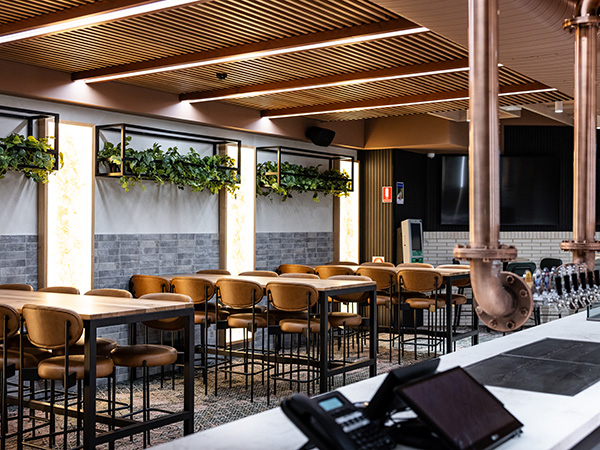
Above: Kiama Leagues Club / Screenwood
With the club being a popular spot for locals and tourists alike, its owners made the decision to engage EMVY Design to help shape the new Cedar Cutters Sports Bar, which would expand the club’s footprint and service its growing community.
“The design brief was to completely transform a car park and storeroom into an entirely new habitable environment with eating and entertaining areas,” says Carley Austin, director of EMVY Design.
“We sought to create a uniquely vibrant space that ignites conversations in comfort. To achieve this, we blended a palette of traditional soft and opulent colours and materials with the space’s industrial elements, and used an exposed salmon ceiling, Italian marble mosaics and rose bronze beer fonts to enhance the ambience.”
Because the bar was surrounded by residential areas and other hospitality venues, it was important to find an acoustic solution that could absorb sound and create warmth, while also complementing the space’s industrial materials.
EMVY ended up selecting Screenwood’s acoustic panels in solid timber for the ceiling and foyer bulkheads to reduce sound reverberation and improve speech intelligibility. Screenwood’s decorative pre-finished Modulo tongue and groove linear lining boards were also chosen to add interest to walls, columns, and seating areas.
“Visually, Screenwood Panels and Modulo create a warm palette which can only be achieved with a natural product like timber,” says Carley.
“We liked how the profiles integrate with each other and the range of finishes available. We particularly chose Screenwood panels as they offer an aesthetic and practical appeal because of their fire and acoustic properties. Their ease of installation and ability to integrate our LED linear lighting systems also played a decisive factor in finalising the specification of Screenwood products.”
One interesting alternative is Atkar’s Au.diCube acoustic ceiling system, which combines stunning timber finishes with a bespoke three-dimensional cubed design.
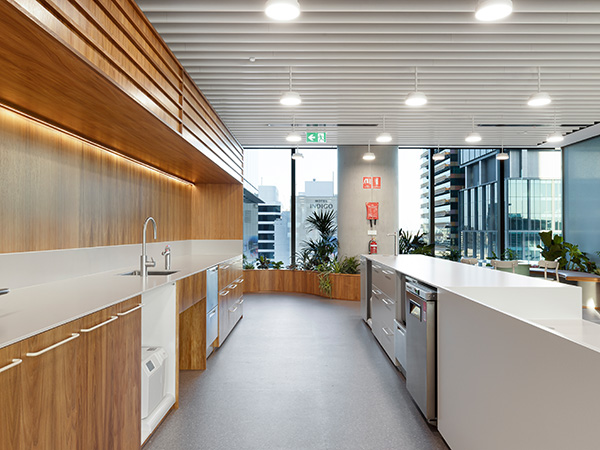
Image: KPMG / MBS Architectural
According to the company, this product was inspired by a client’s desire to create a warm environment without the visual distraction of large perforation patterns, while also achieving high acoustic ability. One of its key advantages is its adaptability. Despite the name, the Au.diCube is not restricted to squares; it can be rectangular, diagonal, or even customised to suit a unique design. It also allows for a wide combination of depth grid layouts with an acoustic lid of choice, plus a diverse range of finishes.
Another alternative is Decor Systems’ Contours of Country product series, a collection of acoustic panels adorned with the artwork of four First Nations artists. Seamlessly blending functionality with cultural significance, not only can this product improve the acoustic quality of commercial spaces, but it also helps foster a deeper connection with the land while supporting the artists directly with a 15 percent share of sales revenue.
The panels were incorporated into some of the architecture at the University of Sydney, allowing the design to achieve its acoustic and safety goals while also paying tribute to the heritage of Indigenous Australians. According to Decor, not only do the panels enhance the campus’s aesthetic and educational value, but they also promote an inclusive atmosphere that respects and celebrates the diversity of its community.
Moving onto some other decorative elements of commercial design, it’s worth mentioning Supawoood’s Supaslat timber ceiling and wall slats, which can be produced in custom sizes and shapes, along with a range of acoustic options to fit a project’s specific needs. According to the company, they are pre-assembled into modules and are designed to be installed with minimum time on-site and no need for specialist labour.
A good example of the product in use is in the Bates Smart-designed Australian Unity headquarters in Melbourne, a project which seamlessly combines an existing heritage structure with contemporary commercial design. Key elements of the brief included the need to accommodate over 1,000 staff in a hub-style workplace with a wellness focus, while also adhering to BCA regulations and Green Star requirements.
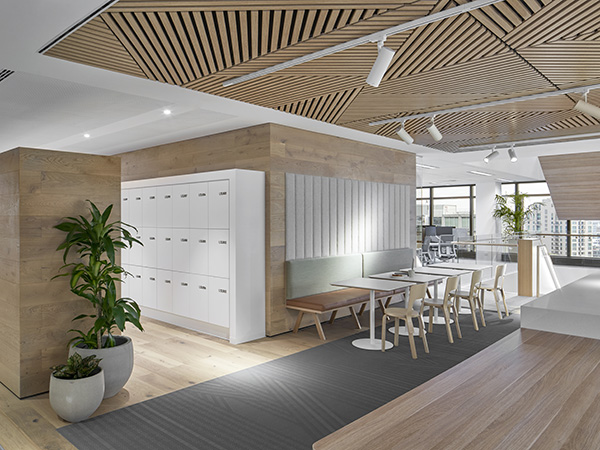
Image: Bates Smart-designed Australian Unity headquarters in Melbourne / Supawood.
Utilising Supaslat’s modular linings system, the project showcased uniquely shaped slatted panels pre-assembled by Supawood, allowing for streamlined installation with no need for on-site modifications. The design featured a crisscross pattern of Supaslat and Supaline panels, framed by Supaline decorative solid panels, defining the communal workspaces and meeting rooms while simultaneously blending aesthetics and functionality.
According to the company, integration was key, with concealed hatches, integrated lighting and black acoustic textile backing being used to address noise reverberation. Both VOC-free and BCA-compliant, the Supafinish Tasmanian Oak laminate also played a crucial role in achieving the project’s 5 Star Green Star and 5 Star NABERS Energy ratings. The result was a workplace design that exemplifies commitment to both employee wellbeing and sustainable design, while carefully balancing heritage and modern design elements.
For those looking for an eye-catching natural finish, stone is another option worth considering. Haus Collective, for example, has a relatively new surface finishing product that is made from solid stone and is split and sawn at the rear for maximum adhesion to any solid substrate. According to the company, this finished stone veneer is often used as an alternative to solid natural stone products because it saves on installation time, money, and natural resources.
Stone cladding is chosen by many builders and contractors because it not only provides an authentic stone finish, but its reduced weight minimises structural support requirements and promotes quick and cost-effective installation. It tends to work well in commercial spaces due to its classic and timeless aesthetic, its durability and most importantly, the fact that every stone feature wall is unique, giving spaces a feeling of individuality and authenticity.
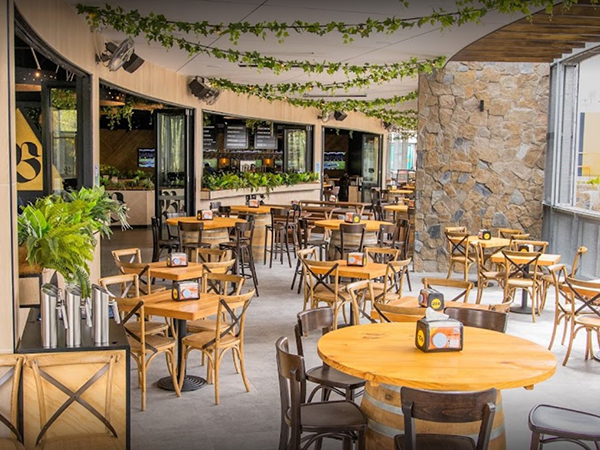
Image: Bavarian Beer Cafe / Haus Collective
On a different note, if you’re looking for a product that can be used in a wide range of commercial design applications, you may want to consider a fibre cement product like Keystone Linings’ perforated fibre cement panels. According to the company, the panels are extremely durable, making them ideal for ceilings, wall panels and wet area applications. Some of their most common use cases are for internal acoustic walls and partitions, eaves linings, fire and party walls, office ceiling and walls, clubs and hotels, foyers, and restaurants, as well as toilet partitions.
A good example of this product in use is in Blight Rayner Architecture’s heritage adaptation of the Jubilee Hotel in Fortitude Valley, Queensland. According to Keystone, the project has breathed life into one of Brisbane’s most iconic boom-era hotels, while also introducing a fresh pub experience with its pavilion extension.
The architects chose to include Keystone’s Key-Endura Fibre Cement Panels in the design because they were able to accommodate the project’s intricate design and sloping ceiling requirements. From the initial drawings to the meticulous manufacturing process, it was important to pay the utmost attention to detail, according to Keystone, and the result was an iconic transformation that showcases design craftsmanship and commitment to excellence.
Speaking of iconic design projects, Enterprise Architectural’s mesh panels are heavily featured in the design of Powerhouse Parramatta, which (upon completion) is expected to be one of the world’s most significant new museums.
The project’s architects were looking for large format mesh ceiling panels for both aesthetic reasons and service integration needs. However, it was a challenge to find a supplier who could offer panels that were large enough to fit the brief. The architects ended up choosing Enterprise Architecture, who were able to develop a bespoke mesh pattern with the use of its Enterprise 310 mesh panels throughout the exhibition spaces — creating an open area aesthetic while also integrating well with services.
According to Enterprise, the building layout required a 2m x 1m panel size, which was larger than what they (or other suppliers) had manufactured previously. In preparation, the Enterprise team carried out a series of tests covering engineering, deflection, and system. They also manufactured and installed a mesh ceiling mock-up in their office to test it and present it to the clients, giving them confidence in the company’s product and service.
Another good metal ceiling option is durlum’s versatile range of metal ceilings (supplied by Network Architectural), including everything from standardised metal ceilings to mesh ceilings, baffle linear ceilings, perforated ceilings and more. According to durlum, the company’s specialty is the creation of unique, bespoke ceilings for commercial projects such as airports, railway stations, shopping centres, offices, schools, sporting venues and outdoor structures.
One exciting project featuring durlum is Sydney Metro’s new Victoria Cross Station, which is located about 31 metres below ground in the heart of North Sydney’s business district. A key feature of the development is its expansive curved ceiling, which is made of 7,000sqm-worth of durlum’s bespoke S7 metal ceiling panels. The durlum ceilings extend from the station’s entrance to the passageways/adit and throughout the grand cavern, resulting in a cohesive flow and stunning finish.
According to Network Architectural, durlum was selected by the project’s architects for its design flexibility as well as the company’s superior end-to-end support and technical advice. What assisted the project was durlum’s ability to collaborate with Network Architectural to provide a locally manufactured and designed subframe system which could accommodate all the seismic design requirements while also providing a suitable interface for the durlum systems. This also assisted the works and installation by contributing to reduced lead times and production flexibility.
If you’re looking for a metal ceiling solution, another good option is SAS International’s SAS500 linear baffle metal ceiling system, which can be directly suspended from the soffit for exposed applications. According to SAS, SAS500’s key benefit is its ability to enhance the acoustic performance of a space, which is achieved with its double-faced panels, making it an appropriate solution for open and exposed interior spaces.
This product was incorporated in the Djerring Flemington Hub (also known as The Hub) in Moonee Valley, Victoria, designed by architects Croxon Ramsay. Aiming to serve as a community space to bring together people of diverse cultural backgrounds, The Hub replaces the Flemington Community Centre, a space which had served the community for more than 60 years until its degradation required it to be demolished in 2021.
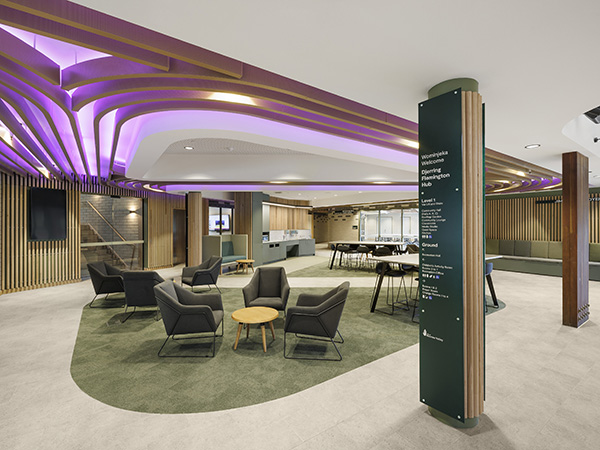
Image: Djerring Flemington Hub (also known as The Hub) in Moonee Valley, Victoria / SAS International.
The space boasts a wide variety of visitor spaces including activity and program rooms, family facilities, creative spaces, consulting rooms, sports changing rooms and recreational facilities. In order to achieve the design brief for metal ceilings, Croxon Ramsay selected SAS International’s SAS500 system in a combination of curved and straight baffles with a golden pearl finish, resulting in a welcoming and flexible community space that combines aesthetic appeal and sound control.
Finally, if sustainability is a concern, another solution worth mentioning is MBS Architectural’s Aluminium Batten Ceiling System, Apollo+. Designed and manufactured in Australia, this product manages to balance aesthetics, ease of installation and commitment to sustainability. According to MBS, the carbon footprint of LocAl Green, the base aluminium for the Apollo+ System, is up to 50 percent lower than the global average for primary aluminium production. Because the company is so committed to making the world a more sustainable place, they even offer Apollo+ at the same price as standard aluminium, making it easier for specifiers to make responsible design choices.
Main image: Decor / Contours of Country
Suppliers
Autex
Atkar
Decor Systems
Durlum Ceilings (Network Architectural)
Enterprise Architectural
Haus
Keystone Linings
MBS Architectural
SAS International
Screenwood
Supawood

